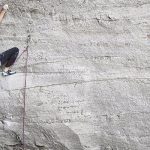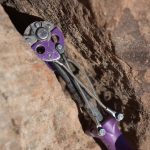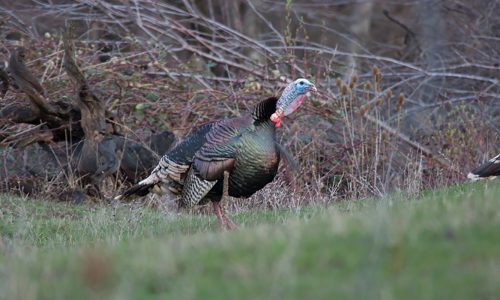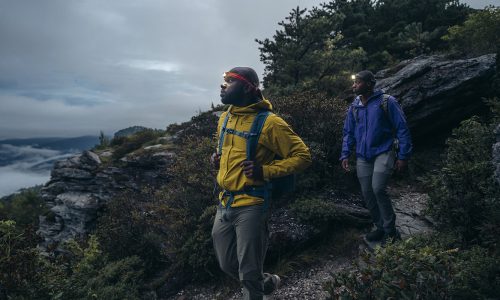Home » Gear Reviews » Climbing » Climbing Cams » Black Diamond Camalot Ultralight
Black Diamond Camalot Ultralight Review
May 15, 2018





















 79
79 The Good
- Lightweight
- Effective ergonomics
- Wide, featured thumb loop
- Durable trigger wires
The Bad
- Stiffest stems tested
- Less stable than other double axle cams
- Durability concerns
- Pricey
Ergonomics
The Camalot Ultralight cams were one of the more popular cams tested in terms of ergonomics. A spacious thumb loop was easy to use by testers whether placing or removing gear, helping take some edge off of those difficult times when at a crux and trying to manipulate and place a cam. The thumb loop is grooved to provide extra purchase and is rigid to ensure it’s always open and easy to access, no matter how far it may be buried in a crack. The trigger is spacious and wide, making it relatively easy to use but testers preferred the curved trigger bar on the Wild Country Friends compared to the flat trigger bar on the Camalot Ultralights. It’s a slight difference in the two but accounts for the edge given to the Wild Country Friends in terms of friendly ergonomics.
Stability
Double axle cams have long been seen as more stable than a traditional single axle cam. Black Diamond revolutionized camming devices with the introduction of the double axle Camalot years ago. Since then the patent has expired and many companies have copied the double axle design. Today, the Camalot Ultralights prove to be more stable than single axle cams but in our testing the Camalot Ultralights weren’t as stable as other double axle cams. During in-house testing in our stability test, the Camalot Ultralights could experience significant movement or “walking” when a rope was moving through the carabiner and the stiff stem connected to a tightly woven and relatively stiff sling seemed to the be the biggest cause. Compared to another double axle cam with a thumb loop, the Wild Country Friends, the Camalot’s tightly woven sling on the thumb loop was observed to contribute to movement of the cam compared to the loosely fitting sling on the Friends, which allowed the sling to move without affecting the cam placement. To some degree, albeit lesser, the cam lobes on the DMM Dragons and Friends are more square cut and “aggressively” built, adding some benefit in enhancing stability.
Durability
The Camalot Ultralights shed significant weight from their C4 predecessors but with that weight savings comes some concern about long term durability. The chief concern is the use of Dyneema for the core stem in lieu of a traditional steel cable stem. The Dyneema core stem is surrounded by plastic, making it durable in the short term but Black Diamond recommends a 10 year lifespan on this Dyneema stem with no way to resling or replace it. For some this short lifespan is cause for concern as many climbers have cams over 10 years old on their racks, merely replacing the sewn sling on the thumb loop periodically. For others, the weight savings and daily utility of the Camalot Ultralight provides reason to use it for its 10 year lifespan and then replace it as some argue you should with much of your gear, including hard goods like carabiners and cams. Other aspects of the Camalot Ultralights held up well, such as the stem and trigger wires. The braided section of trigger wires are covered by a flexible rubber material that effectively protected the wires from getting frayed, as happens on so many cams with use.
Versatility
The Camalot Ultralights shine when weight matters, such as: Alpine climbing objectives where your pack is already stuffed with tent, sleeping bag, food, rope, and the like; long multi-pitch routes where it’s easier to add a few extra, lightweight pieces to the rack to give some peace of mind; or desert splitters where you are lugging multiples in many sizes up steep talus fields. The weight savings of the Ultralights do make it easier to take a few extra pieces as the weight savings is noticeable. They aren’t as effective for aid climbing or horizontal placements where their stiff stems make them less useful. To save weight, BD used Dyneema instead of a traditional steel cable for the stem but to protect that Dyneema it’s enclosed in thick plastic and in testing the Camalot Ultralights had the least flexible stem out of all of the cams tested. Available in seven sizes, the Camalot Ultralights may provide the backbone of your rack but most climbers will want another cam for the tiny, small placements below the .4 size offering (under .5” or finger crack size) and larger cams above the #4 (over 4”). It may also be worth considering their price. Starting at $99.95 and running up to $129.95, they represent one of the most expensive cams on the market and racking up a double set will cause a big hit to the budget.
Features
The standout feature on the Camalot Ultralights are their lightweight, thanks largely to the aforementioned Dyneema core stem, 14mm Dyneema sling and slimming down of other parts like the cam lobes and trigger wires. One popular feature for many climbers on the Camalot C4s are the field replaceable trigger wires. Rather than taking the time to mail in your cams to have frayed or broken trigger wires replaced, Black Diamond has long offered trigger wire kits, allowing climbers to perform their own cam first aid. Unfortunately, the trigger wires on the Camalot Ultralights are smaller than those on the C4s, so those trigger wire kits can’t crossover and be used on the Ultralights. Instead, Black Diamond reinforced the trigger wires by covering the braided wire portion of the trigger wire with a flexible “rubber” material that protects the trigger wire. Despite concerns about durability with the smaller diameter wires used we didn’t experience any frayed or damaged trigger wires despite extensive testing.
Weight
At 74 grams (2.61 ounces) for the .5 sized cam (19.6-33.5 mm range), the Camalot Ultralight is lighter than the other double axle cams on the market but a little heavier than the lightest single axle cams available. Compared to its predecessor, the C4 Camalot, the Camalot Ultralight represents a decent weight savings for cams. Black Diamond advertises the Ultralight as being 25% lighter than the C4s. In real numbers, that means a weight savings of 25 grams (almost an ounce) for a .5 cam. That may not mean much in the context of single cams while a full rack of Camalot Ultralights from sizes .4 to 4 comes in at 1.85 pounds versus 2.38 pounds for the comparable cams in the C4 set. A half pound weight savings per run of cams can add up if you’re taking multiple sets for a desert tower mission or a long day in the mountains on an alpine climb.
Sizes Available w/ Strength Rating, Range and Weight:
.4 – 8 kN – 15.5-26.7 mm (.61-1.04”) – 61 grams (2.15 ounces)
.5 – 10 kN – 19.6-33.5 mm (.77-1.32”) – 74 grams (2.61 ounces)
.75 – 12 kN – 23.9-41.2 mm (.94-1.62”) – 89 grams (3.14 ounces)
1 – 12 kN – 30.1-52.1 mm (1.19-2.05”) – 101 grams (3.56 ounces)
2 – 12 kN – 37.1-64.95 mm (1.46-2.55”) – 126 grams (4.44 ounces)
3 – 12 kN – 50.7-87.9 mm (2-3.46”) – 167 grams (5.89 ounces)
4 – 12 kN – 66-114.7 mm (2.6-4.51”) – 225 grams (7.94 ounces)
These cams went through a number of in-house tests for controlled and measurable metrics and were used by a number of climbers in the field with varying experience levels and interests. Their feedback provided the information to best understand how each cam performed. We spent a lot of time climbing single pitch cracks but an equal amount of time climbing multi-pitch routes in the mountains or in the desert. We paid close attention to how cams handled when being placed or cleaned and by various climbers to gain a sense of each cam’s ergonomics and ease of handling. We looked for signs of walking and stability when placing cams in various cracks of all different sizes.
Schneiter is an AMGA-certified guide, founder of Glenwood Climbing Guides, and very quick on his draws.


















